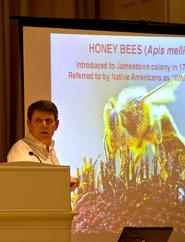
Where have all the honey bees gone? Dr. John P. Burand tried to answer this question on Sept. 29 in his lecture, "Colony Collapse Disorder in Honey Bees: The Tip of the Iceberg." Burand, a professor of entomology at the University of Massachusetts, Amherst, became interested in bees and the viruses that affect them more than a year ago. He spoke at Hamilton as part of the Hamilton Environmental Action Group (HEAG) Green Week.
Surprisingly, bee populations have been steadily declining since the 1940s, and there are virtually no wild bees left. Pretty much any bee you see today came from a beekeeper's hive, sometimes as far as three miles away. Bees are not native to America, but they did first cross the Atlantic in the 17th century with the Jamestown pilgrims. People keep bees in America primarily for pollinating crops, and commercial beekeepers truck their bees all over the U.S. to germinate different crops every year. Bees pollinate more than 90 percent of blueberries, almonds, and apples...imagine if there were no longer enough bees to pollinate, and we never got to eat these three foods again
So what is Colony Collapse Disorder (CCD)? A beekeeper in Pennsylvania first reported CCD in 2006. The symptoms include fewer or no adult bees, but the hive has plenty of larvae and honey. Surviving bees do not want to touch the food, though, nor do predators that would normally gorge on an empty hive. Historically there have been many large die-outs, but the extent of commercial migration of bees to pollinate different crops has spread the disease all around the country, with more than 30 states reporting heavy losses; some experts predict one-third of all honey bees have died since 2006. Some commercial operations have even lost all of their bees.
There's no easy answer to what causes CCD, but Professor Burand suggested four main areas that are probably factors. First, stress on the bees from migration and other factors weakens the bees' immune systems. Secondly, parasitic mites, which live off of, and eventually kill, the bees are a major factor, though these pests are nothing new. Next, pesticides on crops and in people' yards harm the bees. Finally, these factors all lead to pathogens, like bacteria, fungi and viruses, killing off bees that would otherwise be able to fight off these diseases.
There are many studies trying to crack the mystery of CCD and find a cure, but Professor Burand suggested several things people can do to help the bees. Buy local honey and use it instead of other sweeteners. Some local beekeepers have avoided CCD entirely, and more business for them means more healthy bees. People can also promote a more bee-friendly environment by planting flowers. Even not picking dandelions on the lawn helps bees. Those who want to do more can support the Pollinator Protection Act and various bee researchers.
Professor Burand ended with reminding the audience that a spotless apple means it has been covered in pesticides that hurt bees, so he urged listeners to support farmers who grow more natural, less sprayed food.
-- by Greg Huffaker '09
Surprisingly, bee populations have been steadily declining since the 1940s, and there are virtually no wild bees left. Pretty much any bee you see today came from a beekeeper's hive, sometimes as far as three miles away. Bees are not native to America, but they did first cross the Atlantic in the 17th century with the Jamestown pilgrims. People keep bees in America primarily for pollinating crops, and commercial beekeepers truck their bees all over the U.S. to germinate different crops every year. Bees pollinate more than 90 percent of blueberries, almonds, and apples...imagine if there were no longer enough bees to pollinate, and we never got to eat these three foods again
So what is Colony Collapse Disorder (CCD)? A beekeeper in Pennsylvania first reported CCD in 2006. The symptoms include fewer or no adult bees, but the hive has plenty of larvae and honey. Surviving bees do not want to touch the food, though, nor do predators that would normally gorge on an empty hive. Historically there have been many large die-outs, but the extent of commercial migration of bees to pollinate different crops has spread the disease all around the country, with more than 30 states reporting heavy losses; some experts predict one-third of all honey bees have died since 2006. Some commercial operations have even lost all of their bees.
There's no easy answer to what causes CCD, but Professor Burand suggested four main areas that are probably factors. First, stress on the bees from migration and other factors weakens the bees' immune systems. Secondly, parasitic mites, which live off of, and eventually kill, the bees are a major factor, though these pests are nothing new. Next, pesticides on crops and in people' yards harm the bees. Finally, these factors all lead to pathogens, like bacteria, fungi and viruses, killing off bees that would otherwise be able to fight off these diseases.
There are many studies trying to crack the mystery of CCD and find a cure, but Professor Burand suggested several things people can do to help the bees. Buy local honey and use it instead of other sweeteners. Some local beekeepers have avoided CCD entirely, and more business for them means more healthy bees. People can also promote a more bee-friendly environment by planting flowers. Even not picking dandelions on the lawn helps bees. Those who want to do more can support the Pollinator Protection Act and various bee researchers.
Professor Burand ended with reminding the audience that a spotless apple means it has been covered in pesticides that hurt bees, so he urged listeners to support farmers who grow more natural, less sprayed food.
-- by Greg Huffaker '09
Posted September 30, 2008
